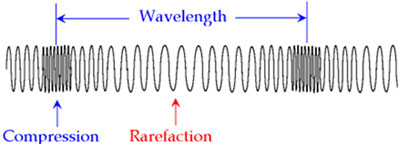
Adapted from: Longitudinal-Wave, Science-Class.net
Waves where the medium vibrates parallel to the direction that the energy is moving are called longitudinal waves. Instead of crests and troughs, a longitudinal wave has areas of high pressure called compressions and areas of low pressure called rarefactions.

Adapted from: Longitudinal-Wave, Science-Class.net
Common examples of longitudinal waves are pressure waves and sound waves.
Just like the transverse waves of the electromagnetic spectrum, there are common longitudinal waves like pressure and sound waves.
![]() Take a moment to watch the following video entitled “Candle in a Compression Wave” and answer the following questions.
Take a moment to watch the following video entitled “Candle in a Compression Wave” and answer the following questions.
Source: Candle in the Compression Wave, chappy128, YouTube
Interactive popup. Assistance may be required.
When the compression wave passes by the candle, it makes the flame move. The stronger the compression wave, the more the flame moves.
Interactive popup. Assistance may be required.
Because a transverse wave moves up and down, some parts of the flame may be more affected than others.
Now that you have had an opportunity to explore and understand basic comparisons of the wave characteristics and behaviors of both transverse and longitudinal waves, you will look more deeply at how these two types of waves compare with one another.